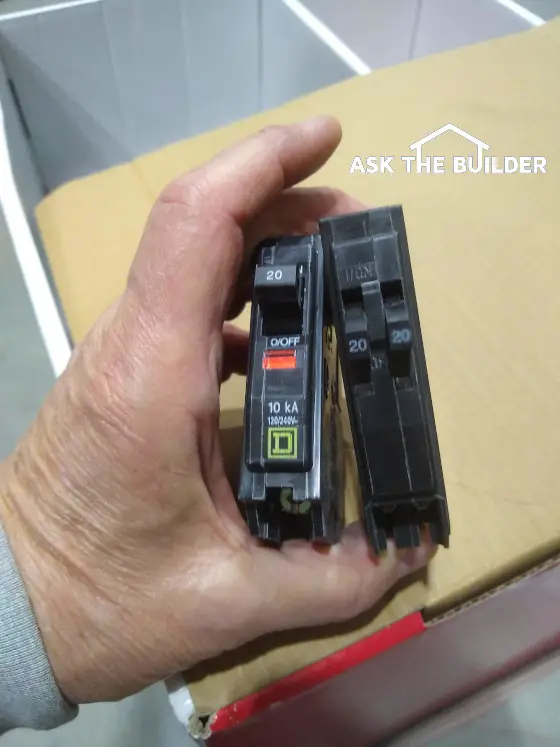What Do Circuit Breakers Do?

Here are two different circuit breakers you might discover in your home. They’re guardians of your life and property! (C) Copyright 2019 Tim Carter
DEAR TIM: Several weeks ago, I read your column in our paper and you talked about installing electrical wiring. I found that very interesting, but now I’m very curious about circuit breakers. What’s the primary purpose of circuit breakers? Are there different types of breakers? What do the numbers on the breakers mean? I’m deeply concerned about house fires caused by electrical malfunctions. Is there any new technology that will give me peace of mind? What else can I do to prevent electrical fires? Valerie B., Kenosha, WI
You may be like Valerie and wonder about those nondescript black rectangles in the electrical panel in your garage, basement, or hallway. The odds are you’ve never had to touch one and if that’s the case that’s actually very good news. On the other hand, if you find yourself routinely resetting a tripped circuit breaker, you should be very concerned.
Circuit breakers are trustworthy guardians of your life and your possessions. Their primary purpose is to protect the integrity of the wires hidden behind your walls and ceilings. A circuit breaker will turn off the power to the wires should it sense too much current passing too quickly and/or if the current draw is so high it begins to overheat the breaker.
Wires behind your walls can be damaged if they heat up. The insulation can melt and catch fire. I’m reminded of a near tragedy at a close friend’s home a little over two years ago. My friend made a mistake of plugging in a portable electric space heater into an outlet that was controlled by a dimmer switch.
Most dimmer switches are only rated for a moderate amount of current passing through them. The usual limit is about 600 watts. The heater was able to draw 1,500 watts and the inside of the dimmer switch got so hot it melted the switch and started to burn. Fortunately, my friend’s wife was in the room, smelled the acrid smoke from the burning plastic and they switched off the power. Had they been elsewhere or asleep, the outcome could have been far different.
It’s important to realize the plastic insulation on wires can do the same thing. If the wire gets too hot, then the insulation can melt, start to burn and create a devastating house fire. The National Fire Protection Association reports that between 2012 and 2016 there were 44,880 residential house fires in the USA directly related to electrical failure or malfunction. Thousands of people died and were injured in these fires. The total property damage estimate exceeded $5 billion dollars. Those numbers should place your head on a swivel.
Another key point is the wires in your home are not all the same size. This is what the numbers on the breakers are for. You need to match a breaker to the minimum size of the wire on a circuit. For example, a 12-gauge wire is normally rated for 20 amps. You’d then use a 20-amp circuit breaker to protect the wires on this circuit.
There are quite a few different circuit breakers. The most common one is a single-pole breaker that operates much like a single wall switch you might use to turn on and off a light in a bathroom. This common breaker takes up one slot in the electrical panel.
You can also purchase unique tandem single-pole breakers where two different circuits are controlled separately yet the two breakers only take one place in the electrical panel.
There are other breakers used to control appliances that need extra power. Your electric oven, electric clothes dryer, a well pump, and exterior air conditioning compressors are great examples. These require a breaker that will switch off all power to the appliance if it senses a problem on either of the two wires that are required to provide the extra power to the equipment.
Decades ago a breaker was developed to protect your body from electrical shocks in wet areas. You may be familiar with the ground fault circuit interrupters, or GFCIs. These breakers can be found in the electrical panel or they might be a point-of-use tiny breaker right on the face of the outlet in your bathroom, kitchen, garage, or an exterior wall outlet.
Not too long after the development of the GFCI, a newer breaker became available that could sense electrical arcing in a circuit that can lead to fires. These are arc-fault breakers and the National Electrical Code has adopted the widespread use of these throughout most new homes. They are a very good idea.
I’m currently testing the latest technology - TingFire. You can now purchase a plug-in monitor that is constantly checking all the wiring in your home for minor arcing that will eventually grow and lead to major arcing that would eventually trip the arc-fault breakers. The new monitor is connected to the Internet and you get an alert via email should it sense a problem in the early stages long before it could cause a fire.
I suggest you do preventative maintenance on all outlets that draw lots of current like your bathroom, kitchen and any other area where you plug in things that consume lots of electricity. You should check to make sure the wires are tightly connected to the outlets. You should also make sure that outlets don’t move when you plug something in or you pull the plug out of the outlet.
Column 1332
One Response to What Do Circuit Breakers Do?